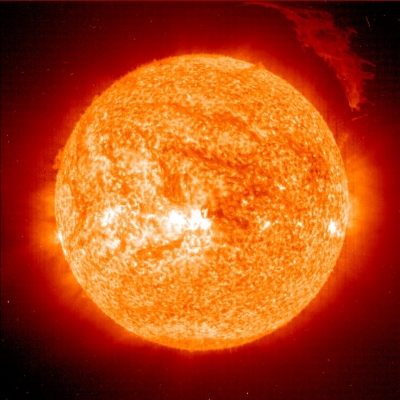2. Thermal Radiation
Matter emits radiation
Experience from daily life shows: Hot objects emit light. A smoldering cigarette shines reddish, a log fire shines yellow, the filament of lamp produces whitish light. This appearently is related to the temperature: The filament is hotter than the log fire whereas the log fire is hotter than the cigarette. It is astonishing that it was impossible to understand the physical laws behind this so called thermal radiation for a long time! Large emphasis was placed on these sciences in the second half of the 19th century.
-
Near 1860, the physicist Gustav Kirchhoff
assumed - he did research on the laws of electric circuits and the analysis of elements on the basis on their spectral lines -
a universal function which explains the emission of light of hot bodies in dependence of their temperature.
He examined how such bodies can absorb light as well. While doing this he found out that the emitted thermal radiation is most intense if a body absorbs the full amount of the incoming radiation. That means it is completely opaque and non-reflecting. He called such kind of objects black bodies.
Since black bodies do not reflect any light, any outcome in radiation must be caused by themselves. This knowledge represents an important simplification for experimental examinations and for the development of physical theories about thermal radiation. -
One could measure that the spectrum of thermal radiation of hot bodies has one maximum and declines on the right and on the left of it.
Sunlight for example is of a maximum brightness in green and declines when passing over to blue and red wavelengths. The area
underneath the spectrum equals the intensity. It has been examinated in experiments by
Josef Stefan and
theoretically by Ludwig Boltzmann.
In 1884, they got a result which nowadays is known as the Stefan-Boltzmann law: The intensity increases with the fourth power of the absolute temperature. A doubled temperature hence has an outcome of a 16 times higher intensity. - Simultaneously to increasing emission at higher temperatures, the maximum is shifted towards shorter wavelengths. In 1893, Wilhelm Wien formulated a law for this phenomenon: The wavelength of the maximum behaves inversely proportional to the absolute temperature. A doubled temperature hence evokes halved wavelengths of the strongest radiation in the spectrum. This is Wien's displacement law.
Despite of these advancements no physical law was found in order to fully explain the measured spectra of thermal radiation of black bodies.
By the help of thermodynamics and the model of electromagnetic waves (see Chapter 1), Max Planck tried to theoretically explain thermal radiation. An equation he invented - it is named Planck's radiation law these days - required the quantisation of electromagnetic waves in order to match the obtained data of experiments. The energy of these quanta then is connect to the waves' frequency according to
The quantity is a constant; the Planck constant with a value of
These in 1900 formulated connections between wave and particle properties of light are considered to be the starting point of quantum theory. The energy quanta of light are the photons (see Chapter 1).

Source: ESA
